Frank's travels around Britain 2011.
Bath, Somerset & Wiltshire.
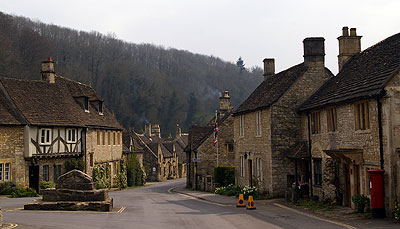 Once
my oncologist said the words "We don't know how many more Christmases we may
have Frank" I wanted to carry on travelling around the UK to revisit my favourite
places. I have always had a special thing about Bath & its surrounding area in
the West Country since I was there in the RAF many moons ago and especially as my friend Cynthia
had never seen that part of England, it was my first choice. Just to give things
an added twist, I had had radiotherapy treatment the week before we left, with
the nurses saying not to worry but things will get worse, before they get better
(they were right!). Plus of course, the weather
forecast being gloomy (what do they know?) and to be honest, if we paid any
attention to what was said on TV, we'd go nowhere!
Once
my oncologist said the words "We don't know how many more Christmases we may
have Frank" I wanted to carry on travelling around the UK to revisit my favourite
places. I have always had a special thing about Bath & its surrounding area in
the West Country since I was there in the RAF many moons ago and especially as my friend Cynthia
had never seen that part of England, it was my first choice. Just to give things
an added twist, I had had radiotherapy treatment the week before we left, with
the nurses saying not to worry but things will get worse, before they get better
(they were right!). Plus of course, the weather
forecast being gloomy (what do they know?) and to be honest, if we paid any
attention to what was said on TV, we'd go nowhere!
Arrival on day one
Staying in Box, a very small town on the main A4 road between Chippenham & Bath, we were ideally situated to cover the whole area without excessive travelling. Arriving there around 2 o'clock, Tom Tom guided us to the nearest Sainsbury's to stock up on fresh stuff and then we had the pleasure of wandering around Castle Combe in the afternoon. It was so good, being out of season & with very few cars to spoil the photographs I was in my element. I was pleased the pictures didn't look too flat without bright sunshine and, as it is always advertised as England's prettiest village, it was great start to Cynthia's introduction to the West Country.
 The village prospered during the fifteenth century, when it belonged to
Millicent, the wife of Sir Stehen Scrope and then of Sir John Fastolf
(1380–1459), a Norfolk knight who was the effective lord of the manor for
fifty years. He promoted the woollen industry, supplying his own troops and
others for Henry V's war in France. The village gives you the impression
little has changed since! Of course, this is nonsense, it is now a stunning,
beautiful, honeypot village. No one throws their night pots out into the
street anymore for sure! Being unique, it has been used as a background for many
films. It was the location for the musical "Doctor Dolittle". Raymond Austin
director/writer, set the action of his book, "Find Me A Spy, Catch me a
Traitor", in the village and at the Manor.
The village prospered during the fifteenth century, when it belonged to
Millicent, the wife of Sir Stehen Scrope and then of Sir John Fastolf
(1380–1459), a Norfolk knight who was the effective lord of the manor for
fifty years. He promoted the woollen industry, supplying his own troops and
others for Henry V's war in France. The village gives you the impression
little has changed since! Of course, this is nonsense, it is now a stunning,
beautiful, honeypot village. No one throws their night pots out into the
street anymore for sure! Being unique, it has been used as a background for many
films. It was the location for the musical "Doctor Dolittle". Raymond Austin
director/writer, set the action of his book, "Find Me A Spy, Catch me a
Traitor", in the village and at the Manor.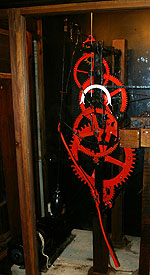 Other productions include "The
murder of Roger Ackroyd", an episode of Agatha Christie's Poirot and the
films "Stardust" & "Wolfman". Throughout September 2010 the village was used as
a key filming location for Steven Spielberg's production of "War Horse".
Other productions include "The
murder of Roger Ackroyd", an episode of Agatha Christie's Poirot and the
films "Stardust" & "Wolfman". Throughout September 2010 the village was used as
a key filming location for Steven Spielberg's production of "War Horse".
The 14th century market cross, erected when the privilege to hold a weekly market was granted, is situated where the three principal streets converge. Some small stone steps near the cross were for horse riders to mount and dismount, and close by are the remains of the buttercross.
A unique feature of Castle Combe's medieval church of St. Andrew's, is the home of the Castle Combe Clock, one of the very few English medieval clocks still in use. There are no known documents that show an exact date when the clock was manufactured, but it is of similar construction to the Exeter Cathedral Clock, the Marston Magna Clock, and the Cotehele Clock at Saltash Cornwall. A comparison with those clocks makes it likely that it was constructed in the late 15th century.
Sometime after 1670, the clock was converted from verge escapement and foliot to a pendulum. For the conversion, the clock was turned upside-down and the release mechanism for the hour strike was adapted to the new positioning of the clock. In 1984, the clock was taken down from the bell tower to the nave of the church, and put on a concrete plinth in a wooden cabinet with glass panes. The moving parts were painted bright orange, and a minute hand with a 180 degree dial was added. The manual winding spokes were removed and electric winders were installed for both going and striking train.
 Day
Two
Day
Two
Trying to judge the weather, we started our next day in Avebury as it was fine for walking in the open air. Although Stonehenge has the name, this village, built inside the stone circle, is just fascinating. It is thought that the village began its life as a defensive position during the Saxon invasion, but by the 6th century the Saxons themselves were making their homes within the circle. They named it Weala-dic meaning "the ditch of the Britons". Their stone built church made an appearance in the 10th. century just outside the original pagan temple.
Just to wander freely amongst the stones, (one weighing over 100 tons & the tallest 7"m or 21 feet) puts the effort into construction on such a human scale. Historians think that just erecting one stone may have taken up to a year to complete. There were 101 stones in the outer circle encompassing another 30 in the inner one. Just the motivation to take so long to complete their plans must have been all consuming for generation after generation.
 Avebury is a Neolithic henge containing three stone circles which is
located in & around the village. Unique amongst megalithic monuments,
Avebury contains the largest stone circle in Europe, and is one of the best
known prehistoric sites in Britain. It is currently used, not just for
tourists, but as a place of religious importance to contemporary Pagans.
Constructed around 2600 BC, during the Neolithic or New Stone Age, the
monument comprises of a large henge,
surrounded by a bank and a ditch. Inside this henge is a large outer stone
circle, with two separate smaller stone circles situated inside the centre
of the monument. The ditch is about 1 mile in circumference & it's estimated
that 100,000 cubic metres (4 million cubic feet) of chalk were moved
by human muscle, using the basic tools of antlers & bone to loosen it & then
carry it away in baskets. The height of the bank is 18 feet & the depth of
the ditch is 30 feet! Its original purpose is not known, although archaeologists
believe that it was most likely used for some form of ritual or ceremonial
usage. The Avebury monument was a part of a larger prehistoric landscape
containing several older monuments nearby, including West Kennet Long Barrow
& Silbury Hill.
Avebury is a Neolithic henge containing three stone circles which is
located in & around the village. Unique amongst megalithic monuments,
Avebury contains the largest stone circle in Europe, and is one of the best
known prehistoric sites in Britain. It is currently used, not just for
tourists, but as a place of religious importance to contemporary Pagans.
Constructed around 2600 BC, during the Neolithic or New Stone Age, the
monument comprises of a large henge,
surrounded by a bank and a ditch. Inside this henge is a large outer stone
circle, with two separate smaller stone circles situated inside the centre
of the monument. The ditch is about 1 mile in circumference & it's estimated
that 100,000 cubic metres (4 million cubic feet) of chalk were moved
by human muscle, using the basic tools of antlers & bone to loosen it & then
carry it away in baskets. The height of the bank is 18 feet & the depth of
the ditch is 30 feet! Its original purpose is not known, although archaeologists
believe that it was most likely used for some form of ritual or ceremonial
usage. The Avebury monument was a part of a larger prehistoric landscape
containing several older monuments nearby, including West Kennet Long Barrow
& Silbury Hill.
We should say a word about the National Trust cafe in Avebury. Although their prices can make you drop your tray, the staff are very helpful at adapting their menus. Its often quite difficult to find places with gluten free items available on the menu, these people also coped with a lactose intolerance with no problems at all. Well done NT!
 Then it was
on to Lacock, yet another gem of a honeypot village!
Then it was
on to Lacock, yet another gem of a honeypot village!
Lacock is mentioned in the Domesday book, with a population of 160–190; with
two mills and a vineyard. Lacock
Abbey was founded on the manorial lands by Ela, countess of
Salisbury and established in 1232; (Ela was the daughter of William, Earl of
Salisbury and was married to William Longespee, the illegitimate son of
Henry II. William was one of the most powerful barons of the time and was a
witness of the Magna Carta). The village — with the manor — formed
its endowment to "God and St Mary". Lacock was granted a market and
developed yet another thriving wool industry
during the Middle Ages.
Reybridge, and a pack horse ford, remained the only crossing points of the River
Avon until the 17th century. The Abbey nuns were mostly ladies of
good family, usually between fifteen and twenty-five in number, but the
community was increased by a number of lay sisters, who looked after the
more menial tasks, and guests who came for hospitality. In the Abbey
interior is the Warming Room, the only room where the nuns had a fire. Here there is a cauldron of bell metal that dates from 1500, and made by
Peter Wagheuens of Malines. At the Dissolution, the Abbey and estate,
including the village, were sold to William
Sharington, later passing into the Talbot family by marriage.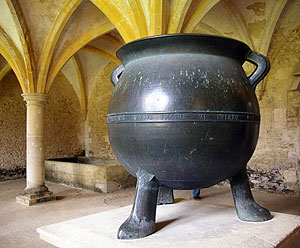
Most of the surviving houses are 18th century or earlier in construction. There is a 14th century tithe barn, a medieval church, and an inn dating, possibly from the 15th century, and an 18th century lock-up. In 1916 Charles Henry Fox Talbot bequeathed the Lacock estate to his niece, Matilda Gilchrist-Clark, who took the name of Talbot. The estate was given to the National Trust in 1944 by Matilda Talbot – comprising 284 acres, the Abbey, and the village.
Like Castle Combe, the village has been used as a film and television set, notably for the 1995 BBC production of Pride and Prejudice and the 2007 BBC production of Cranford. It has also made brief appearances in the Harry Potter films, mainly in and around the Abbey. Since 1958 it has featured in over 20 productions.
The village is so nice to wander around. There are plenty of places to eat, the bakery is recommended for a tasty snack served by cheerful staff in costume. There is a delightful church with the Awdry family laid to rest there, the ancestors of the Reverent gentleman who gave us Thomas the Tank Engine. The Abbey has the museum celebrating the achievements of William Henry Fox Talbot, famous for his contributions to the invention of photography, and the interior is splendid for atmospheric pictures of its vaulted ceilings.
After completing my radiotherapy only days before, I found out that you can't do too much! Around three in the afternoon, I had to go back to the car and rest. I must have slept for about 40 minutes. My usual get up and go, got up and went. It was obvious that on this break, I would have to pace myself and not try to cram in every single place I wanted to visit.
Day Three
 Today the weather was looking overcast and I thought I might need to find places to sit down during the day (pace yourself Frank!), so it was off to my favourite city, Bath. There is nowhere like Bath for me. It has everything ... history from many ages, unique sights and real beauty. The prices
can be inexpensive and eye watering at the same time!
Today the weather was looking overcast and I thought I might need to find places to sit down during the day (pace yourself Frank!), so it was off to my favourite city, Bath. There is nowhere like Bath for me. It has everything ... history from many ages, unique sights and real beauty. The prices
can be inexpensive and eye watering at the same time! 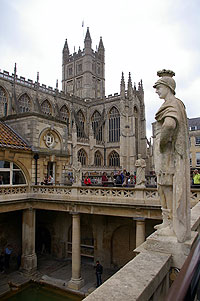
Evidence shows that the site of the Roman Baths main spring was treated as a shrine by the Iron Age Britons and was dedicated to the goddess Sulis whom the Romans identified with Minerva. However, the name Sulis continued to be used after the Roman invasion, leading to the town's Roman name of Aquae Sulis (literally, the waters of Sulis). The temple was constructed in 60–70 AD and the bathing complex was gradually built up over the next 300 years. The city was given defensive walls, probably in the 3rd century. After the failure of Roman authority in the first decade of the 5th century, the baths fell into disrepair and were eventually lost due to silting up.
A monastery was set up in Bath at an early date in the medieval period. King Offa of Mercia gained control of this monastery in 781 and rebuilt the church, which was dedicated to St. Peter. By the 9th century the old Roman street pattern had been lost and Bath had become a royal possession, with King Alfred laying out the town afresh, leaving its south-eastern quadrant as the abbey precinct. Edgar of England was crowned King of England in Bath Abbey in 973.The Anglo-Saxons called the town something like Bašum, meaning "at the baths", and this was the source of the present name. It is known that the hot springs were being used in the ninth century as Nennius, the historian, mentions a "Hot Lake" in the land of the Hwicce.
By the 15th century, Bath's abbey church was badly dilapidated and in need of repairs. The new church was completed just a few years before Bath Priory was dissolved in 1539 by Henry VIII. The abbey church was allowed to become derelict before being restored as the city's parish church in the Elizabethan era, when the city experienced a revival as a spa. The baths were improved and the city began to attract the aristocracy. Bath was granted city status by Royal charter by Queen Elizabeth I in 1590. Several areas of the city underwent development during the Stuart period, and this increased during Georgian times in response to the increasing number of visitors to the spa, and resort town, who required accommodation.
As you walk around, Roman is next to Georgian. Finding a nicer city to spend your time in is rare. There are so many memorable spots. Around 1770 Robert Adam designed Pulteney Bridge, using as the prototype, a design by Palladio for the Rialto Bridge in Venice, and Pulteney Bridge became not just a means of crossing the river, but also a shopping arcade. Along with the Rialto Bridge it is one of the very few surviving bridges in Europe to serve this dual purpose.
The fabulous architecture of the Royal Crescent and my favourite, the Circus, are both wonderful examples of Georgian buildings. Just to see the street name chiseled out of the Bath stone is a joy. The Abbey is magnificent. I have never seen a place so encrusted with memorial plaques inside its walls, floors and hidden corners!
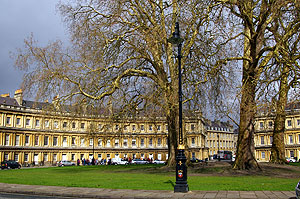
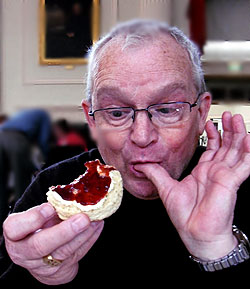 Another favourite was the Pump room, with its punctilious waiters, grand
piano player and beautiful decor, all with prices to match. I can still see Cynthia's face
when I quoted Afternoon Tea for two at £34! All I had, was A scone, clotted
cream, fruit preserve ("We don't 'ave Jam Sir!") & a pot of Darjeeling for
£9.25. As she put it so well. "If we have to be stupid once in our
lives, let's do it in style." We actually saw several ladies having "Afternoon
Champagne Tea" at £48 a brace!
Another favourite was the Pump room, with its punctilious waiters, grand
piano player and beautiful decor, all with prices to match. I can still see Cynthia's face
when I quoted Afternoon Tea for two at £34! All I had, was A scone, clotted
cream, fruit preserve ("We don't 'ave Jam Sir!") & a pot of Darjeeling for
£9.25. As she put it so well. "If we have to be stupid once in our
lives, let's do it in style." We actually saw several ladies having "Afternoon
Champagne Tea" at £48 a brace!
Although the weather was dull, it was a pleasure just wandering around. The Royal Crescent was still magnificent and scruffy at the same time. The nearby estate agent (they seem to breed estate agents in Bath) had a nice house at four and a half million. I wonder if the desire to live at such an address leaves you no cash to keep it up to spec? It's a grade 1 building, it must cost outrageous sums to maintain it.
The Circus, a circle of houses built on four
quarters, all overlooking a green mound with huge mature trees in its
centre is, to me, much more attractive. The only thing to marr the view was
the dead grass under the tree. Being fair, it is only just after winter and it
may look beautiful later on in the year.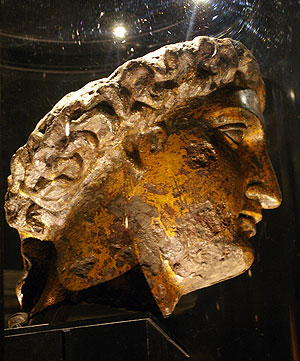
Of
course the outstanding place to visit is always the Roman Baths. At just
under £10, its not cheap but the effort put in, the staff and maintenance must
be colossal. The displays inside are very well done, especially the
circular Bath (not lit on our visit, unfortunately) with it's effective
lighting and ghostly Roman figures projected on the walls, all seeming to talk as they move around the bathing
areas.  They have
partial displays of the finds from the site. These are enhanced by a
projected image which shows how they think the objects would have looked
originally. The head of Minerva is quite stunning,
beautifully illuminated on a stand. You can get so close to it and see every
detail. As you enter you can have an audio guide and this provides loads of
information. Unfortunately this does provide log jams of stationary tourists
all intently gazing ahead and listening to the box glued to their ears. I can
imagine that in the summer the place would be at a standstill. Of course,
Frank was at fault too. I mis-timed the visit and tried to rush us round a bit
before the parking ticket ran out!
They have
partial displays of the finds from the site. These are enhanced by a
projected image which shows how they think the objects would have looked
originally. The head of Minerva is quite stunning,
beautifully illuminated on a stand. You can get so close to it and see every
detail. As you enter you can have an audio guide and this provides loads of
information. Unfortunately this does provide log jams of stationary tourists
all intently gazing ahead and listening to the box glued to their ears. I can
imagine that in the summer the place would be at a standstill. Of course,
Frank was at fault too. I mis-timed the visit and tried to rush us round a bit
before the parking ticket ran out!
In various locations are actors dressed in Roman clothes portraying their parts. Full of information and staying in character, they are such an asset to the whole experience. All this, plus the smells, colour of the flowing hot water and the slight mist everywhere, does help take you back in time so easily, and with a little imagination you're back there in Roman Britain in the third century.
During our rambles around the city, we came across a character in a doorway who sneezed. Being a gentleman I said "Bless you" and he replied in a Somerset accent " Tis the snuff, Sir!". Now this was either a Mr. Bumble or the original Mr. Darcy who had finally gone to seed. We had come across, by accident, the meet and greet personage of the Jane Austin Museum in Gay Street! By now, the day had run out, so I planned to return the next day to complete our Bath visit with a trip to this unique place.
Day four
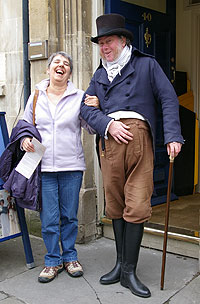 Our
timing the next day was perfect. No real sunshine to speak of and a good time
to go inside a museum. Unfortunately, our Mr. Darcy was a bit cheesed off
with tourists just taking his photo and going off without visiting this shrine
to Jane. I made the error of asking to take his photograph with Cynthia, and
before you knew it, he was inside rambling incoherently as we stayed on his
extensive coat tails. It turned out that there are tours of the museum but only at set
intervals and if you get it wrong, the doors are locked and you're not allowed
round without your guide. Guess who got the timing wrong again? "Lets just
have a cream tea while we wait" says I. Ooooh no, bad idea again. The cafe
was staffed by a
lovely girl from Czechoslovakia who encouraged us to try a warm crumpet with
clotted cream and honey. Oh boy, was she right! It was delicious, about 1000
calories a bite again but worth having a heart attack for! That made us late
and Cynthia missed one of her favourite author's guided tours! We were very
naughty, dodged under ropes at the exit and looked around on our own ... not
too impressed but then we never heard the full story.
Our
timing the next day was perfect. No real sunshine to speak of and a good time
to go inside a museum. Unfortunately, our Mr. Darcy was a bit cheesed off
with tourists just taking his photo and going off without visiting this shrine
to Jane. I made the error of asking to take his photograph with Cynthia, and
before you knew it, he was inside rambling incoherently as we stayed on his
extensive coat tails. It turned out that there are tours of the museum but only at set
intervals and if you get it wrong, the doors are locked and you're not allowed
round without your guide. Guess who got the timing wrong again? "Lets just
have a cream tea while we wait" says I. Ooooh no, bad idea again. The cafe
was staffed by a
lovely girl from Czechoslovakia who encouraged us to try a warm crumpet with
clotted cream and honey. Oh boy, was she right! It was delicious, about 1000
calories a bite again but worth having a heart attack for! That made us late
and Cynthia missed one of her favourite author's guided tours! We were very
naughty, dodged under ropes at the exit and looked around on our own ... not
too impressed but then we never heard the full story.
Jane Austin never lived at this house but one further up the street (of similar construction they said). She was only in the city for 5 years and said she didn't like Bath anyway! I admire anyone who tries so hard to impress tourists! As we made our way out, Mr. Darcy granted our request of a picture and smiled broadly as he cheekily propositioned Cynthia for a kiss! It was a great way to end a very strange visit!
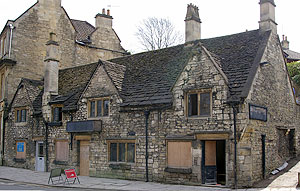 After Bath, our target was Bradford on Avon,
but it was the season for
rebuilding. The last time I was
there I heard that there was a plan to renovate many buildings in Bradford
by 2012 and they were obviously getting on with renewing certain areas at last. I saw that the ancient Three Gables was under renovation now after so many years.
Apparently it was a cafe and not, as it appears, a derelict pub.
On top of the bridge is an old small building.
It was originally a chapel but later
used as a town lockup. The weather vane was still there. It has a weather vane in
the form of a gudgeon (an early Christian symbol), hence the local saying
"under the fish but over the water". The cafe I remembered from the last
visit, Granny Moe's, had given up the ghost. However, we did find an unusual
cafe beside the canal, which
served us well. It used a small butty boat as it's dining room. A really good idea, especially in the wet. I was delighted with Bradford on Avon the last time
but on this trip it all seemed a little disappointing.
After Bath, our target was Bradford on Avon,
but it was the season for
rebuilding. The last time I was
there I heard that there was a plan to renovate many buildings in Bradford
by 2012 and they were obviously getting on with renewing certain areas at last. I saw that the ancient Three Gables was under renovation now after so many years.
Apparently it was a cafe and not, as it appears, a derelict pub.
On top of the bridge is an old small building.
It was originally a chapel but later
used as a town lockup. The weather vane was still there. It has a weather vane in
the form of a gudgeon (an early Christian symbol), hence the local saying
"under the fish but over the water". The cafe I remembered from the last
visit, Granny Moe's, had given up the ghost. However, we did find an unusual
cafe beside the canal, which
served us well. It used a small butty boat as it's dining room. A really good idea, especially in the wet. I was delighted with Bradford on Avon the last time
but on this trip it all seemed a little disappointing.
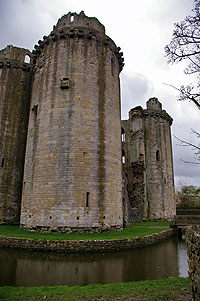 We
continued on to that well hidden gem, Nunney, yet another place from the
Domesday Book. What a lovely, quiet, pretty village that seems to be lived
in by real people who accept a HUGE 11th century castle of French design as
quite normal. It is free to see and well looked after despite its battered state after the English civil war.
Complete with moat, it is a stunning surprise in this tiny village.
We
continued on to that well hidden gem, Nunney, yet another place from the
Domesday Book. What a lovely, quiet, pretty village that seems to be lived
in by real people who accept a HUGE 11th century castle of French design as
quite normal. It is free to see and well looked after despite its battered state after the English civil war.
Complete with moat, it is a stunning surprise in this tiny village.
I quote from my last visit. Nunney Castle is a small, French-style castle surrounded by a deep moat, built for Sir John Delamare in 1373, (Sir John had fought with the Black Prince in France, and his gatehouse here included some of the very latest French fashions in construction). It is so worth seeing. The rooms, floor levels & turret details are all so clear. It was later the property of William Paulet, 1st Marquis of Winchester, before passing to several more owners. During the English Civil Wars (1642-51) Colonel Richard Prater, who held the castle until 1645, lost it to Fairfax, the commander of Cromwell's forces in the battle that took place at Nunney. The castle was besieged for two days, but capitulated when Cromwell's men used cannon to blast a great hole in the north wall of the castle.
Since writing that, I found this written in 1887 by a Benjamin Edward
Rawlings, and published in the Somerset Standard, as Village Histories No. 1
Nunney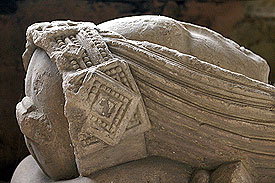
During the Civil War the castle was garrisoned for the King and had a
large magazine. In August, 1645, Fairfax arrived at Castle Cary; on the
18th he met Colonel Rainsborough with two regiments, Col. Hammond’s and his
own, to attack Nunney Castle. On September 8th it surrendered after a
desperate defence. It is said that during the siege the garrison to delude
the besiegers caused a young sucking pig they chanced to have to be conveyed
to one of the back towers where its cries could be distinctly heard, and
there, pulling him violently by the ears and tail, would have it believed
they killed a pig every day. A deserter from the castle betrayed them, and a
36-pounder gun having been brought from Shepton, the wall before alluded to
was battered down and a breach being made, the garrison surrendered.
The number is stated to have been 14, by others 24. Seven of the
besiegers were killed. The loss of the garrison was the deserter. When
Cromwell’s Army entered they burnt the building to prevent its future use
for the King. Colonel Prater was owner and also commanded the castle, and
not wishing his place destroyed surrendered, and offered to change his
allegiance and hold the place for Parliament.
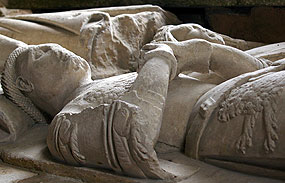 Since my last visit there only seems to have been an odd
shop added to the village. The superb George pub and the glorious All
Saints' church
still enhance this bucolic scene. It's the centre of Englishness and
carries on without the need to encourage tourists. (I never have found a car
park!). The George was officially closed, being 4 o'clock in the afternoon,
but they still gave us a warm welcome with coffee and biscuits.
Since my last visit there only seems to have been an odd
shop added to the village. The superb George pub and the glorious All
Saints' church
still enhance this bucolic scene. It's the centre of Englishness and
carries on without the need to encourage tourists. (I never have found a car
park!). The George was officially closed, being 4 o'clock in the afternoon,
but they still gave us a warm welcome with coffee and biscuits.
Inside All Saints' church are five magnificent effigies to the people mentioned above. Sir John De La Mare who built Nunney castle, who died in 1383, ten years after completing his castle. Richard Prater and his wife, of Civil War fame, and Sir John Paulet, (who died in 1437) with his wife Constance. Throughout the years, all of them have been knocked about a bit (not a nose left between them), but the gorgeous details still survive. They effigies must have been things of beauty in their day.
Over the western pillar of the arcade is a painted figure thought to represent St George. It was discovered underneath the whitewash in 1895. I just love little details like that.
Without question it was a great trip, despite the effects of the radiotherapy and how uncomfortable it made me feel. I must admit, at the end of each day I felt completely worn out. Cynthia loved the West Country but discovered the same thing that I did. It's either stunningly beautiful or very scruffy ... we drove through the scruffy places without stopping!
The next planned trip is Cornwall and we're looking forward to that one just as much.
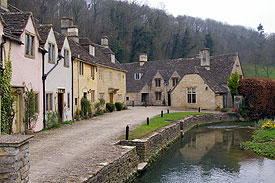

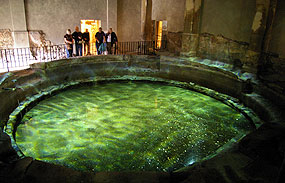
Links for information on this page:
Castle Combe
Avebury
Lacock
Bath
Nunney
